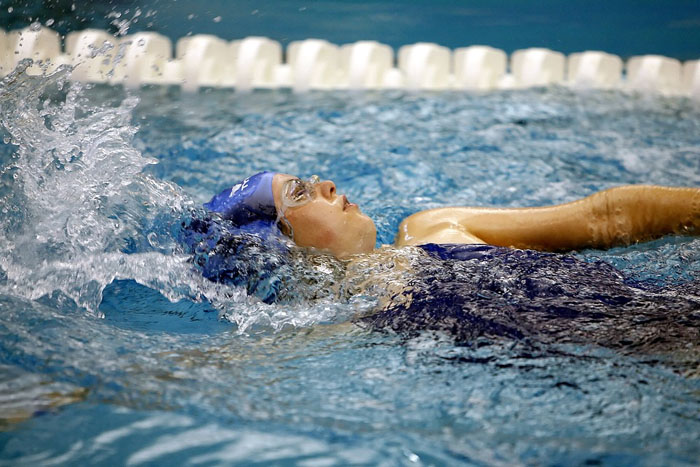Sports Biomechanics is the application of physics and mechanics to the human body during sport. In such a technical sport such as swimming, it plays a very important role in elite swimmers preparation and is an important part in maximizing performance. Here are a few applications of biomechanics to the sport of swimming. See also the article on swimming hydrodynamics.
 Swimming backstroke
Swimming backstrokeThrough the water
Water is 773 times as dense as air and 55 times as viscous. From the start of a race, the body position on the block must be maximized to achieve the most efficient push off and get the body in position to enter the water, to make the 'hole ' to follow in through. Biomechanics also helps to understand the best body position to reduce drag following the dive, to maximize the speed that is achieved off the blocks. After the push off the wall, body position is also important to have a streamlined glide away from the wall and reduce drag. For each swimming stroke, the technique has developed over the years due to close examination and research by sports biomechanics staff.
Body Suits
Biomechanics has also been involved in the development of the swimming suit that is often seen on the world swimming stage. The friction due to the flow of water over the body of the swimmer causes drag and slows the swimmers down. Science has developed swimming suits that, though several different principles, reduces this drag.
In February 2008 the LZR Racer was released, followed by many others in the lead up to the 2008 Beijing Olympics. Some of the attributes of these suits include ridges on the suit to reduce turbulence and flow the water around the body, tight fitting suits that give proprioceptive feedback to help keep body form in the water, and surface pockets that hold air or water particles in the surface layer of the suit (like dimples in a golf ball), reducing surface friction.
After debating whether these suits should be allowed, FINA decided on these regulations to be in place from the World Championships in 2009:
- Suit no more than 1 mm thick
- Suits not to extend past the shoulders or ankles
- No tailored suits
- No more than one suit at a time
Was wearing such advantageous swimsiuts cheating? As with all new technologies, it is not cheating as long as it is within the rules and regulations of the sport. Athletes will try for any advantage that they can, and sometimes stretch the rules, and I don't blame them. If the swimsuits are not available for all athletes then it can give an unfair advantage to those athletes who wear these suits. In such cases the governing body of the sport should look at changing the rules so that it is a more even playing field for all the competitors, which they have done for the suits. It is another issue about what they should do with all the records that were broken during the time that the suits were used.
Shaving Heads
Most swimmers wear a swimming cap, but others prefer to shave their heads and even the rest of their body in what they call a 'shave down' before a big race. For the same reason that swimmers will wear a body suit, the hair on the body causes drag in the water. Drag, otherwise known as resistance, slows the swimmer down. By making the head smooth and streamlined, water flows more smoothly over it. Latex or lycra caps can do the same thing for those that prefer to keep their hair on their heads.
Related Pages
- See also the article on swimming hydrodynamics.
- An Unfair Advantage for Swimmers - a discussion on the new swinsuits
- Biomechanics and Physics of Sports
- Technological Doping in Sports
- More Swimming Science


 Current Events
Current Events